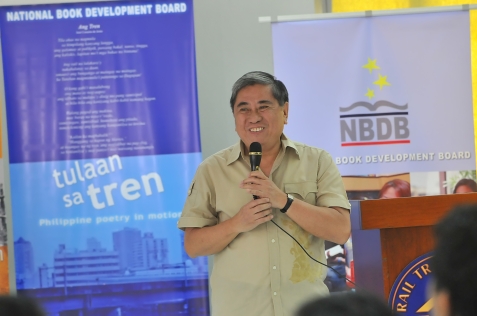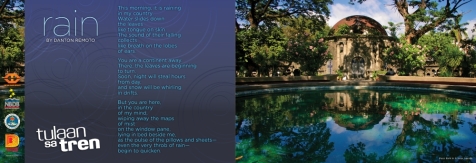



BY Danton Remoto
Remote control
Views and analysis section
http://www.abs-cbnNEWS.com
December 30, 2008
“Read to lead” is a soundbite that we hear more often these days. Happily for us, the National Book Development Board (NBDB), the government agency tasked with doing this, is working hard and fast to make sure that our people – especially the young and those glued to their YouTubes – would also find the time to read.
But words need not be fixed just on the page. The NBDB, under the inspired leadership of executive director Andrea Pasion-Flores, has taken the act of reading into the 21st century.
Proof number 1: their “Tulaan sa Tren” project in the LRT Line 2 station that runs from Recto in Manila to Santolan in Marikina. It is a take-off of the poems read and posted at the Tube (subway) of London, but who cares?
In partnership with the Optical Media Board and the Book Development Association of the Philippines, the NBDB chose poems from some of the country’s best writers, asked a host of celebrities to read them, and printed the poems on small posters. The readings are broadcast on the LRT stations every morning and late afternoon, in time for the rush hours, and also at noon.
And the poems? Printed on coated paper and set beside colorful photographs by Jay Alonzo, the poems are posted on the LRT trains, at the eye level of our harried commuter.
Our lawyer and fiction writer who now heads NBDB said: “We hope that people who will perhaps encounter our poetry for the first time in this novel way will realize that Philippine literature is something that we can all be proud of. I hope that they will also look up the authors, whose works we featured, so that they could discover more treasures.”
Among the readers of the poems were Edu Manzano, Miriam Quiambao, Nikki Gil, Matt Evans, Lyn Ching-Pascual, Romnick Sarmenta, Harlene Bautista, Chin-Chin Gutierrez, Rhea Santos and Christine Bersola-Babao.
And the list of poets is headed by National Artist Virgilio Almario (a.k.a. Rio Alma), Jose Corazon de Jesus, Cirilo F. Bautista, Gemino Abad, Benilda Santos, Marjorie Evasco, Jose Lacaba, Vim Nadera, Conchitina Cruz and myself.
When they were asking my permission for my poem “Rain” to be included in the “Tulaan sa Tren” project, I teased the NBDB by saying: “ I have written nationalistic poems and religious poems, why do you want an erotic poem?”
“Rain” is my most anthologized poem, written a thousand years ago, and I am glad that Harlene Bautista did a great job of reading it. Several students of mine sent me text messages when they heard the poem inside the train, or being broadcast on the LRT stations. They said it was, uhh, kinda sexy and one of my fellow teachers at Ateneo said that now, you are a public poet, à la Pablo Neruda, because your poems are no longer read just in the solitude of one’s library carrel.
So on that sunny afternoon, celebrities and poets took the LRT train from Santolan to Recto and back, then launched Rio Alma’s latest book of poems, the appropriately titled Mga Biyahe, Mga Estasyon (Journeys, Junctions), with luminous translations by Marne Kilates and published by Anvil.
One of the assigned readers failed to make it to the event, so Karina Bolasco of Anvil asked me to read one poem in Filipino with an English translation. I promptly said, “Yes,” and read the two works en face. Anvil gave me a free copy of the book, and the one I bought I cheerfully gave to my fellow Ateneo teacher Danny Reyes.
And if you think that was clever enough, NBDB then sponsored a reading of Jose Rizal’s Noli Me Tangere from Nov. 8 to 9. Yes, an all-night reading that continued well into the next morning. We read from Virgilio Almario’s excellent translation of the Noli, which was a winner of the National Book Award, handed out by the Manila Critics Circle.
I was assigned to read the hilarious chapter on the neighbors who outdid each other in counting their accumulated rewards in heaven. It just convinced me that, indeed, Rizal is not just our national hero but a great writer as well. He could X-ray the very motivations of the characters, and then show to us their shadow and light against the sun.
Proof positive of Rizal’s timeless novel is the Penguin Edition of Noli Me Tangere, whose first and second printings have sold out. The third printing is also selling briskly, proving that Rizal’s timeless novel still has a home in the hearts of readers in the 21st century. A hundred years ago, one man wrote two novels that led to his death – and to the precious freedom that we now all enjoy.




